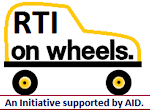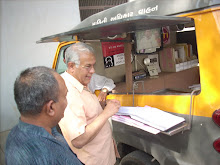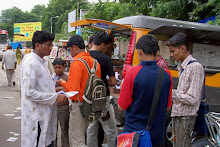The Week: Delhi: Sunday, 25 Feb 2024.
The documents revealed Centre went ahead with the scheme despite reservations by ECI
Many of the documents that
throw light on the circumstances in which the government decided to introduce
the Electoral Bonds Scheme and crucial statistics about the sale and purchase
of bonds were made available in the public domain as a result of the relentless
pursuit of facts and figures made by Commodore Lokesh Batra (Retd) using the
Right to Information.
The 78-year-old Batra, a Navy veteran who describes himself as a transparency campaigner, has been using the RTI in the public interest since the early 2000s. Batra's tryst with the RTI began when he settled down in Noida, on the outskirts of the national capital, after his retirement on December 31, 2002.
His first RTI application was about the poor quality of water supplied to the homes in the satellite town of Delhi. The effort paid off and it was evident to him that the RTI could be used as a powerful tool to bring out information on issues of public interest.
When the infamous Nithari killings, which happened in Noida, came to light in December 2006, Batra filed many RTIs which brought to the fore shocking information about the utter failure of the public authorities in acting on the complaints that they had received.
In 2020, when the government cleared the way for individual and institutional contributions to the National Disaster Relief Fund, Batra had a big role to play in that. He had made several representations to the government to allow individuals to contribute to the fund.
His RTI efforts include seeking information about the expenses incurred during Prime Minister Narendra Modi's foreign visits, the PM CARES Fund and the Prime Minister's Relief Fund.
It was because of his initiative that the Electronic Indian Postal Orders that made it possible for Indians living abroad to pay RTI fees became a reality.
When the Electoral Bonds Scheme was announced by the then Finance Minister Arun Jaitley in the union budget speech of 2017, Batra set out on a mission to dig out information that would provide clarity on the discussions that had taken place within the government and the other relevant authorities such as the Election Commission and the Reserve Bank of India about the bonds. The many documents that he procured through his RTI applications were correspondences between the EC and the government, and those between the RBI and the government with regard to the scheme. These documents made it clear that the government had gone ahead with the scheme despite the serious reservations expressed about it by the EC and the RBI.
He consistently filed RTI applications to the State Bank of India, which was authorised by the government to issue the bonds, to bring to the fore information about the amounts involved, and the trends about the bonds that were sold between 2018 and now.
Many of the documents and the statistics procured by him using RTI formed the basis of the arguments put forth by the petitioners before the Supreme Court in their challenge to the scheme.
“From my work experience, which included the time in the power corridors in Delhi, I have an idea of how work happens in the government departments. That helped me in procuring information using RTI,” says Batra.
He says one requires immense patience in digging out information using RTI because the culmination of a single effort can take months. “I prefer to seek files rather than ask specific queries. One can extract information from the files and also get leads for more information that can be procured,” he says.
Batra was commissioned into the Indian Navy on May 22, 1967. He served in various capacities both ashore and afloat and attained the grade of Charge Hydrographer. He retired as Secretary Kendriya Sainik Board.
During the 1971 war, Batra, then a Lieutenant, had actively participated in the campaign on the western front. When the first ship M V Successful Day, suspected to be carrying contraband, was captured by the Navy, Batra had boarded the ship in the night and brought it safely to Mumbai harbour.
The Navy veteran is now an RTI warrior.
The documents revealed Centre went ahead with the scheme despite reservations by ECI
 |
| Lokesh Batra |
The 78-year-old Batra, a Navy veteran who describes himself as a transparency campaigner, has been using the RTI in the public interest since the early 2000s. Batra's tryst with the RTI began when he settled down in Noida, on the outskirts of the national capital, after his retirement on December 31, 2002.
His first RTI application was about the poor quality of water supplied to the homes in the satellite town of Delhi. The effort paid off and it was evident to him that the RTI could be used as a powerful tool to bring out information on issues of public interest.
When the infamous Nithari killings, which happened in Noida, came to light in December 2006, Batra filed many RTIs which brought to the fore shocking information about the utter failure of the public authorities in acting on the complaints that they had received.
In 2020, when the government cleared the way for individual and institutional contributions to the National Disaster Relief Fund, Batra had a big role to play in that. He had made several representations to the government to allow individuals to contribute to the fund.
His RTI efforts include seeking information about the expenses incurred during Prime Minister Narendra Modi's foreign visits, the PM CARES Fund and the Prime Minister's Relief Fund.
It was because of his initiative that the Electronic Indian Postal Orders that made it possible for Indians living abroad to pay RTI fees became a reality.
When the Electoral Bonds Scheme was announced by the then Finance Minister Arun Jaitley in the union budget speech of 2017, Batra set out on a mission to dig out information that would provide clarity on the discussions that had taken place within the government and the other relevant authorities such as the Election Commission and the Reserve Bank of India about the bonds. The many documents that he procured through his RTI applications were correspondences between the EC and the government, and those between the RBI and the government with regard to the scheme. These documents made it clear that the government had gone ahead with the scheme despite the serious reservations expressed about it by the EC and the RBI.
He consistently filed RTI applications to the State Bank of India, which was authorised by the government to issue the bonds, to bring to the fore information about the amounts involved, and the trends about the bonds that were sold between 2018 and now.
Many of the documents and the statistics procured by him using RTI formed the basis of the arguments put forth by the petitioners before the Supreme Court in their challenge to the scheme.
“From my work experience, which included the time in the power corridors in Delhi, I have an idea of how work happens in the government departments. That helped me in procuring information using RTI,” says Batra.
He says one requires immense patience in digging out information using RTI because the culmination of a single effort can take months. “I prefer to seek files rather than ask specific queries. One can extract information from the files and also get leads for more information that can be procured,” he says.
Batra was commissioned into the Indian Navy on May 22, 1967. He served in various capacities both ashore and afloat and attained the grade of Charge Hydrographer. He retired as Secretary Kendriya Sainik Board.
During the 1971 war, Batra, then a Lieutenant, had actively participated in the campaign on the western front. When the first ship M V Successful Day, suspected to be carrying contraband, was captured by the Navy, Batra had boarded the ship in the night and brought it safely to Mumbai harbour.
The Navy veteran is now an RTI warrior.














































































